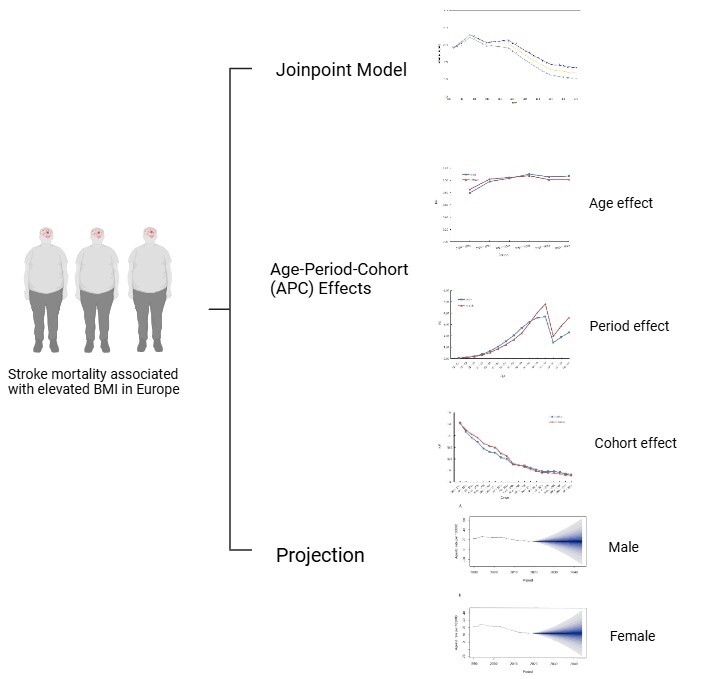Current issue
Archive
Manuscripts accepted
About the Journal
Editorial office
Editorial board
Section Editors
Abstracting and indexing
Subscription
Contact
Ethical standards and procedures
Most read articles
Instructions for authors
Article Processing Charge (APC)
Regulations of paying article processing charge (APC)
EPIDEMIOLOGY / RESEARCH PAPER
Trends in stroke prevalence caused by an elevated BMI in the European population
1
the First Affiliated Hospital of Wannan Medical College, China
2
School of Medicine, Macau University of Science and Technology, China
These authors had equal contribution to this work
Submission date: 2024-09-01
Final revision date: 2024-12-03
Acceptance date: 2024-12-19
Online publication date: 2025-02-22
Corresponding author
Hui Peng
the First Affiliated Hospital of Wannan Medical College, No. 2, Zheshan Road, 241000, Wuhu, China
the First Affiliated Hospital of Wannan Medical College, No. 2, Zheshan Road, 241000, Wuhu, China
KEYWORDS
TOPICS
ABSTRACT
Introduction:
This study investigated the complex relationship between an elevated body mass index (BMI) and stroke risk in Europe amidst rising obesity rates and an aging population.
Material and methods:
A joinpoint model was used to fit the data on stroke mortality rates attributed to an elevated BMI. The age period cohort model was used to analyze the effects of age, period, and birth cohort on trends in stroke prevalence related to an elevated BMI from 1990–2019 in the European context. A Bayesian model was used to predict stroke mortality from increased BMI in Europe in 2020-2044.
Results:
Stroke mortality rates attributed to an elevated BMI displayed a wave-like declining trend in Europe, decreasing from 21.73/100,000 in 1990 to 14.01/100,000 in 2019. The most substantial decline in stroke mortality rate occurred between 2003 and 2013 ( -4.10%,P<0.001). Male mortality rates decreased from 21.48/100,000 in 1990 to 15.45/100,000 in 2019, while female rates declined more significantly from 21.40/100,000 in 1990 to 12.48/100,000 in 2019. Age-standardised stroke mortality due to increased BMI is expected to decline in Europe over the next 25 years.
Conclusions:
From 1990 to 2019, stroke mortality rates associated with elevated BMI in Europe steadily increased. However, projections indicate that this trend may shift, with a slight decline expected in the near future. Given these patterns, there is an urgent need in Europe to enhance weight management strategies for stroke patients and increase public health awareness, particularly focusing on men and the elderly, to help reduce stroke-related mortality.
This study investigated the complex relationship between an elevated body mass index (BMI) and stroke risk in Europe amidst rising obesity rates and an aging population.
Material and methods:
A joinpoint model was used to fit the data on stroke mortality rates attributed to an elevated BMI. The age period cohort model was used to analyze the effects of age, period, and birth cohort on trends in stroke prevalence related to an elevated BMI from 1990–2019 in the European context. A Bayesian model was used to predict stroke mortality from increased BMI in Europe in 2020-2044.
Results:
Stroke mortality rates attributed to an elevated BMI displayed a wave-like declining trend in Europe, decreasing from 21.73/100,000 in 1990 to 14.01/100,000 in 2019. The most substantial decline in stroke mortality rate occurred between 2003 and 2013 ( -4.10%,P<0.001). Male mortality rates decreased from 21.48/100,000 in 1990 to 15.45/100,000 in 2019, while female rates declined more significantly from 21.40/100,000 in 1990 to 12.48/100,000 in 2019. Age-standardised stroke mortality due to increased BMI is expected to decline in Europe over the next 25 years.
Conclusions:
From 1990 to 2019, stroke mortality rates associated with elevated BMI in Europe steadily increased. However, projections indicate that this trend may shift, with a slight decline expected in the near future. Given these patterns, there is an urgent need in Europe to enhance weight management strategies for stroke patients and increase public health awareness, particularly focusing on men and the elderly, to help reduce stroke-related mortality.
Share
RELATED ARTICLE
We process personal data collected when visiting the website. The function of obtaining information about users and their behavior is carried out by voluntarily entered information in forms and saving cookies in end devices. Data, including cookies, are used to provide services, improve the user experience and to analyze the traffic in accordance with the Privacy policy. Data are also collected and processed by Google Analytics tool (more).
You can change cookies settings in your browser. Restricted use of cookies in the browser configuration may affect some functionalities of the website.
You can change cookies settings in your browser. Restricted use of cookies in the browser configuration may affect some functionalities of the website.



